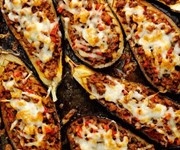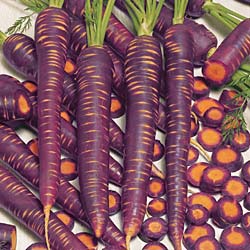The best purple foods
We pick a lovely autumnal colour and focus our foodie efforts on it. Last time it was green, but today we're focusing on five wonderful PURPLE foods.
Figs
 What is it? The wondrous fruit from the ‘Ficus tree’. Dried figs are more prevalent than their fresh counterpart, although we prefer the latter… such a mellow, flowery taste, with smooth skin and crunchy seeds. Fresh figs sport a deep purple colour when ripe, although can be eaten green too. We think of all the fruits, figs leave the best aftertaste.
What is it? The wondrous fruit from the ‘Ficus tree’. Dried figs are more prevalent than their fresh counterpart, although we prefer the latter… such a mellow, flowery taste, with smooth skin and crunchy seeds. Fresh figs sport a deep purple colour when ripe, although can be eaten green too. We think of all the fruits, figs leave the best aftertaste.
In season: Californian figs are available from June to September, although some European varieties last throughout the whole of autumn.
Fun fact: The ever-popular fig roll (now made by Jacobs) actually dates back to an ancient Egyptian pastry, which was filled with fig paste.
How to eat it: Figs are supposed to be eaten whole, skin and all, so give them a good wash first. Or you could simmer them for several minutes in water or fruit juice to make them plumper and juicier. OR, even better, make our fig ice cream, or pistachio and fig biscotti.
My best fig memory: Popping a couple just now, at my desk. Far more exciting than an apple.
Aubergine
 What is it? Aubergine, or eggplant as the Americans would have it, is technically a berry, although it is widely used in cooking as a vegetable. It’s grown all over the world but you’re most likely to spot the glossy, bulbous beast in Mediterranean cuisine. All varieties share the same buttery texture and mildly smoked flesh, which is spongy when raw but soft when cooked.
What is it? Aubergine, or eggplant as the Americans would have it, is technically a berry, although it is widely used in cooking as a vegetable. It’s grown all over the world but you’re most likely to spot the glossy, bulbous beast in Mediterranean cuisine. All varieties share the same buttery texture and mildly smoked flesh, which is spongy when raw but soft when cooked.
In season: All year round, but it’s at its best from May to October.
Fun fact: The Italians call it ‘melanzane’, which means ‘crazy apple’.
How to eat it: Slice thinly lengthways, then fry or griddle immediately in a hot pan with plenty of olive oil. Or try our Sicilian baby aubergine salad, aubergine and courgette gratin, or lamb-stuffed aubergines recipes.
My best aubergine memory: Eating thin griddled slices of aubergine drowned in olive oil at a caff just outside Palermo airport in Sicily. Best airport food I ever had.
Red cabbage
 What is it: Red cabbage, a member of the brassica family, is definitely more purple than it is red… although strictly speaking, the colour depends on the pH value of the soil. It’s been cultivated in Britain since the Middle Ages and can be enjoyed raw, normally in coleslaw.
What is it: Red cabbage, a member of the brassica family, is definitely more purple than it is red… although strictly speaking, the colour depends on the pH value of the soil. It’s been cultivated in Britain since the Middle Ages and can be enjoyed raw, normally in coleslaw.
In season: All year round.
Fun fact: This isn’t very ‘fun’, but if a dog eats too much raw red cabbage it can cause ataxia. Poor pups.
How to eat it: Braise it with apples and spice like Delia does, chuck it into coleslaw raw, or simply blanch for 3-4 minutes. Even better, use it to top these tasty pulled pork tacos.
My best red cabbage memory: Making a huge vat of the stuff with cinnamon, apples and sultanas for Christmas dinner last year. We were still eating it in January.
Heritage carrots
 What is it? Heritage carrots (the carrots which our forebears enjoyed) come in all sorts of colours – the purple ones just happen to be our favourite. Seeds from the earliest cultivars of carrots have been traced back to prehistoric dwellings in Switzerland, and these colourful varieties tend to be much sweeter than your typical orange carrot.
What is it? Heritage carrots (the carrots which our forebears enjoyed) come in all sorts of colours – the purple ones just happen to be our favourite. Seeds from the earliest cultivars of carrots have been traced back to prehistoric dwellings in Switzerland, and these colourful varieties tend to be much sweeter than your typical orange carrot.
In season: All year. Although you’re more likely to find heritage carrots in the shops come winter time.
Fun fact: The typical orange carrot is in fact a ‘mutant’ carrot… it appeared as a mistake in the 17th century, and was developed by Dutch growers who liked the colour.
How to eat it: Raw, sliced into salads to add colour; steamed; roasted in the oven with herbs and a little honey…
My best heritage carrot memory: Snapping open a grubby-on-the-outside heritage carrot for the first time, and marvelling at the shocking purple colour within.
Purple fruit pastilles
 What is it? Purple Fruit Pastilles are by far the best Fruit Pastille flavour. Blackcurrant beats orange, lemon, lime and strawberry hands down; everyone’s favourite is always either purple or red. Rowntree’s first made Fruit Pastilles in 1881 Tyneside, before which the manufacture of gums and pastilles had been a French Monopoly. Each sweet measures 1.5cm in diameter and they contain real fruit juice, believe it or not.
What is it? Purple Fruit Pastilles are by far the best Fruit Pastille flavour. Blackcurrant beats orange, lemon, lime and strawberry hands down; everyone’s favourite is always either purple or red. Rowntree’s first made Fruit Pastilles in 1881 Tyneside, before which the manufacture of gums and pastilles had been a French Monopoly. Each sweet measures 1.5cm in diameter and they contain real fruit juice, believe it or not.
In season: All year round, funnily enough.
Fun fact: Did you know that the red Fruit Pastille used to be raspberry flavoured, until it was changed to strawberry in the 1990s?
How to eat it: Fruit Pastilles aren’t for sucking. Chew, chew, chew!
My best purple Fruit Pastille memory: Getting four purple Fruit Pastilles in a row from a recent tube. Bliss.
Red cabbage image courtesy of NaJina McEnany
You might also like
Comments
Do you want to comment on this article? You need to be signed in for this feature